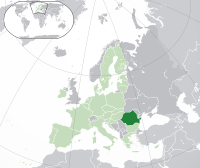+40

Location of Romania (dark green)
|
|
| Location | |
|---|---|
| Country | Romania |
| Continent | Europe |
| Access codes | |
| Country calling code | +40 |
| International call prefix | 00 |
| Trunk prefix | 0 |
The dialling plan for mobile networks (numbers starting with 07) and new landline operators (numbers starting with 03) is closed; all subscriber numbers must be dialled in full. For landline numbers starting with 02, the dialling plan used to be open; the trunk digit and area code could be omitted if the caller was in the same area code as the callee. However, starting May 3, 2008, all landline numbers must be dialled in full.
During the Communist years, there was no direct international access. Numbers had 5 digits except for Bucharest, where numbers were 6 digits long. Area code started with 9 and were 2 digits long for Bucharest (90-xxx-xxx) and 3 digits long (9pp-xx-xxx) for the rest of the country. The Bucharest surrounding area had the area code 909, followed by 5 digits number. Somewhere in the end of the 80s, some big cities' area codes were upgraded, including the last digit of the area code into the local number, thus making it 6-digits long. However, calling between non-local areas always required dialling the area code, even when the called party's code was the same as the caller's. For example, a number from Iași was 981-xx-xxx, then it became 98-1xx-xxx. A number from Suceava was 982-xx-xxx, but then it became 98-2xx-xxx. Apart from Bucharest, Brașov was the first city to have 6-digit numbers.
Many smaller town or rural area calling implied using manual commutation circuits operated by humans.
Short numbers for special services, like cab companies, were three digits long, starting with 0:
After 1989, the then-monopolistic state-owned phone company started a process of upgrading its facilities. In 1992, it started increasing the size of a number to 7 digits in Bucharest and 6 digits in the rest of the country and by changing the prefixing scheme. The long distance code was changed from 9 to 0, the area code for Bucharest became 01, while to the rest of the country was temporarily given a 0 before the older area codes. For a short period, the surrounding of Bucharest (now Ilfov county) had the area code 0179, which has been eventually included into the Bucharest numbering plan as 01-79x-xxxx. The 02 code was used for calls to the Republic of Moldova.
In 1993, the other counties were given new area codes (30 to 69). The previous area code system did not follow the country administrative regions. Outside county dialing required a national access code 0 (01-xxx-xxxx to Bucharest and 0pp-xxx-xxx for the rest of the country). In-county calling could be done without prefixes at all (xxx-xxxx to Bucharest and xxx-xxx for the rest of the country). Calling from outside meant +40-1-xxx-xxxx for Bucharest and +40-pp-xxx-xxx for the rest of the country. An international access code for calling abroad, 00, was adopted. County codes were selected on a geographical order, starting with northern Moldavia (Suceava County had 30), then going southwards to eastern Wallachia, than westwards to Banat, then northern Transylvania and it ends in the southern Transylvania, until the highest prefix, 69 (used for Sibiu County). The short numbers for special services started with 9 and were three digits long. Each town or county has its own special services, callable with the same number throughout the country.
...
Wikipedia
